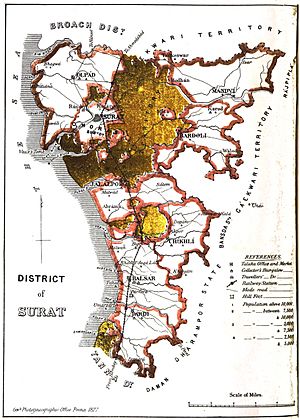John Vaux facts for kids
Quick facts for kids
John Vaux
|
|
|---|---|
| Born | 1630s-1650s |
| Died | 1697 |
| Cause of death | Drowning |
| Occupation | Book-keeper (-1685)
Civil Judge (1685-90) Deputy Governor of Bombay (1690-92) |
John Vaux was an important person in the East India Company during the late 1600s. He served as the Deputy Governor of Bombay in 1689. Sadly, he and his wife drowned in the Tapti River in 1697. A special landmark called Vaux's Tomb was built near the river. It helped sailors find their way to the city of Surat.
Contents
John Vaux's Early Life
John Vaux grew up in England. He first worked as a book-keeper for Sir Josiah Child. Sir Josiah Child was a former Governor of the East India Company.
A book called 'History of Gujarat' says that Vaux was a good worker. Because of this, his master made him a supercargo. A supercargo was in charge of a ship that traded with China.
Soon after, Vaux traveled to Bombay. There, he became a factor. A factor was a business agent. In 1685, he was made a Civil Judge. His job was to deal with pirates and people who traded illegally.
Vaux wrote a letter to Sir Josiah Child. He thanked him for the important jobs and power he had received. He wrote that he would follow the laws of his country.
A Disagreement About Rules
However, this remark upset the head of the India House. He wrote back that Vaux should follow his orders, not the laws of England.
The judge of the Admiralty court at the time, St John, also complained. He felt that Vaux was not qualified to be a judge. He thought Vaux did not know enough about law for such an important role.
Despite these issues, John Vaux was promoted. When Bartholomew Harris became Governor of Bombay in 1690, Vaux became the Deputy Governor.
Accusation of Spying
In 1692, John Vaux was removed from the company. He was suspected of secretly talking with the French. This was seen as a serious betrayal.
Later, a book by Alexander Hamilton said that Vaux had become unfriendly towards the English. After this event, Vaux did not have any other major jobs.
Vaux's Tomb Landmark
As mentioned, John Vaux and his wife drowned in the Tapti River in 1697. Their boat flipped over while they were on a ride.
To honor the couple, a tomb was built. It became known as Vaux's Tomb.
The tomb was built at the mouth of the river. It had a dome about 30 feet high. This tall structure was a very important landmark for sailors and traders. It told them they had reached the city of Surat. Surat was once a very important port city and trading center in India.
Vaux's Tomb is even mentioned in Daniel Defoe's famous book, Robinson Crusoe. A poem about Surat by Marianne Young also talks about the Tomb. She said it was a popular place for picnics.
Hazira's Name Origin
Today, Hazira is a major port in India. It is a very important part of the Surat Metropolitan Region.
The village where the tomb is located was first called Dhau. The name Hazira actually comes from Vaux's Tomb. Local Gujaratis called John Vaux ‘Bakas’ or ‘Vakas’. They called the tomb ‘Bakasno Hajiro’. The word ‘hajira’ comes from Persian and means tomb. Over time, this name was given to the village of Dhau.
See also
- Deputy Governor
- East India Company
- Hazira
- History of Surat
- List of governors of Bombay Presidency
- Tapti River


